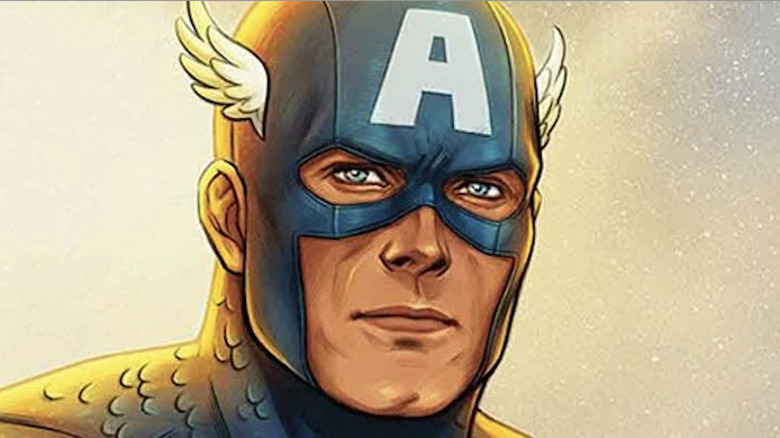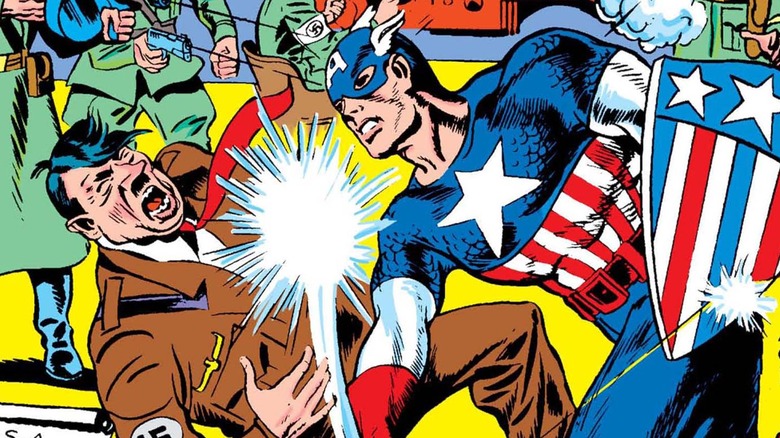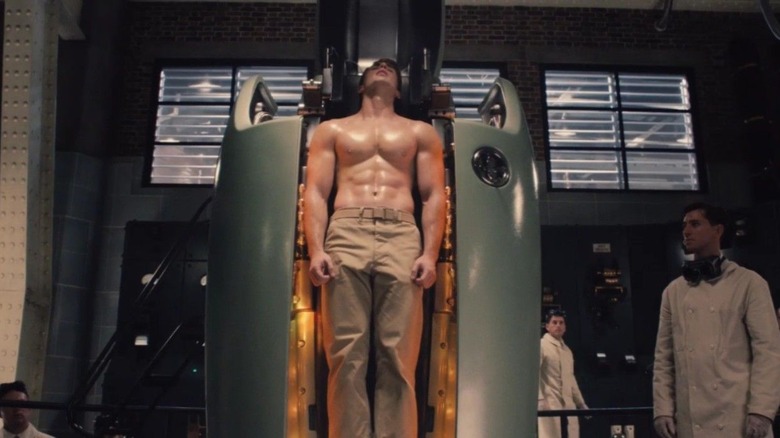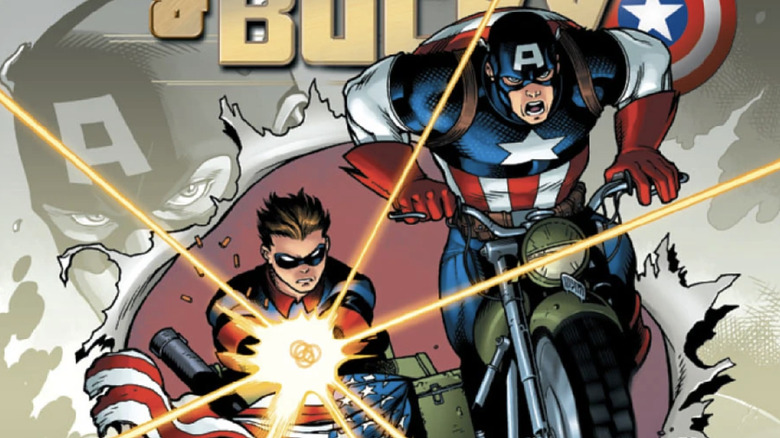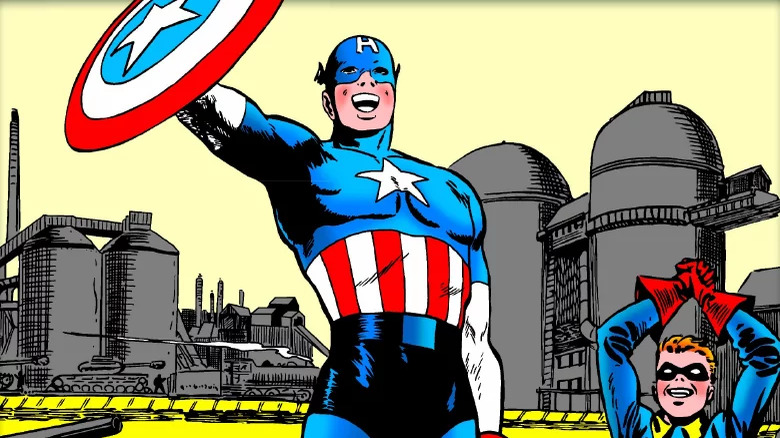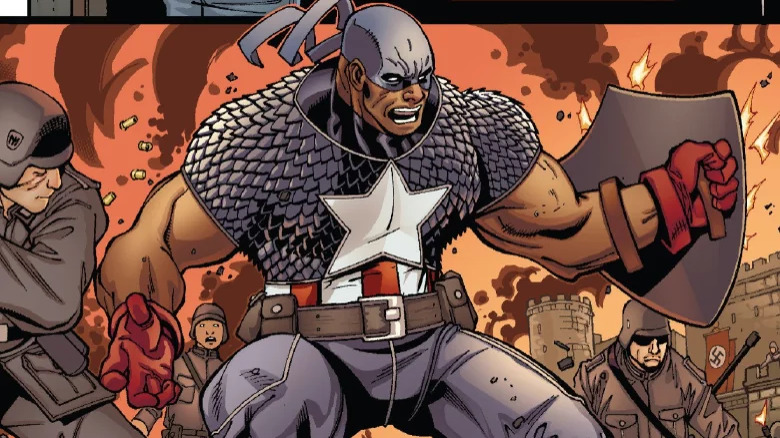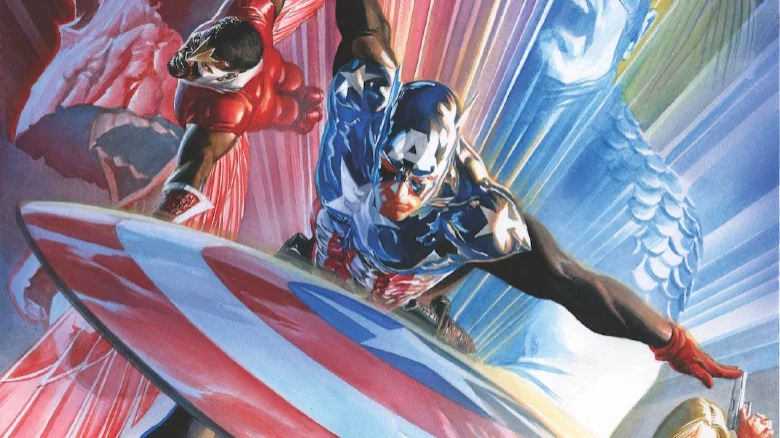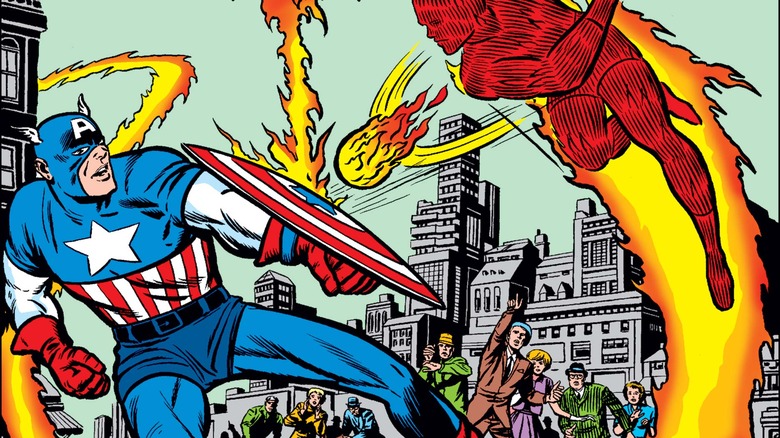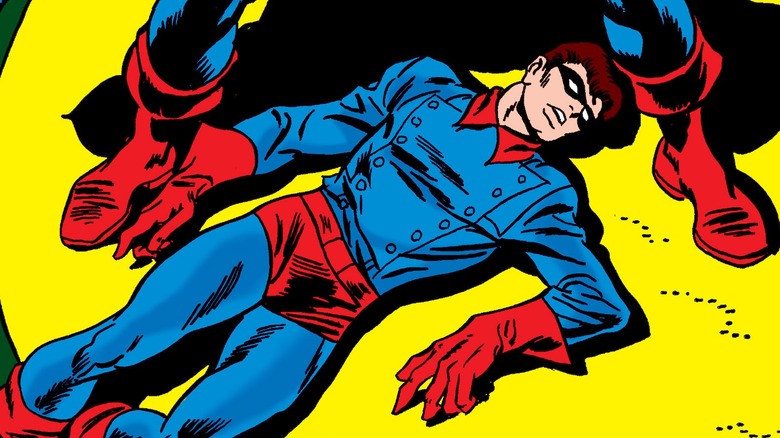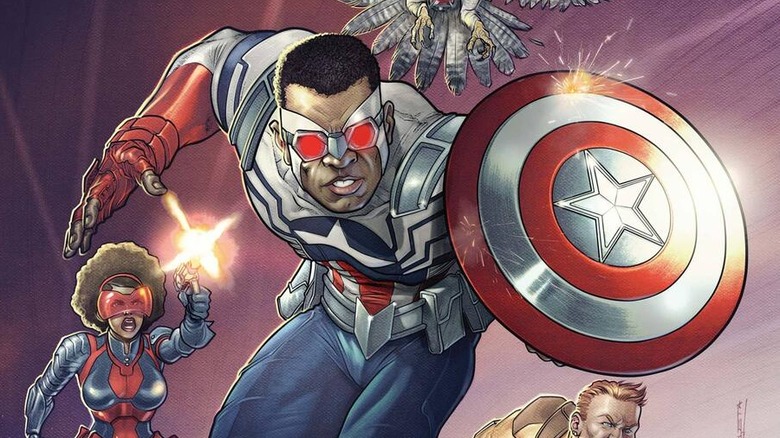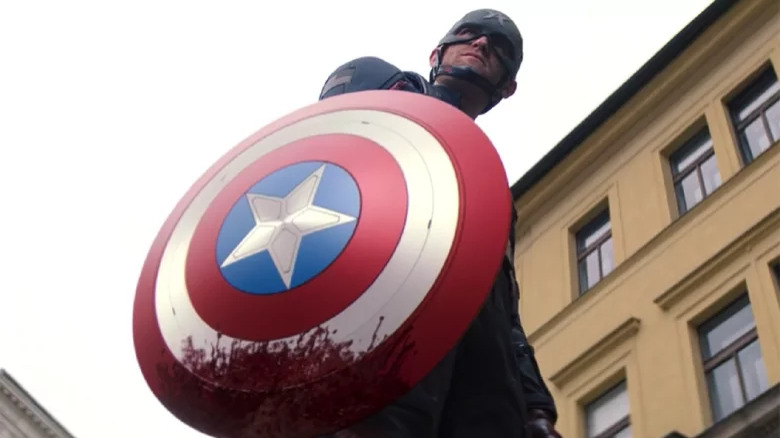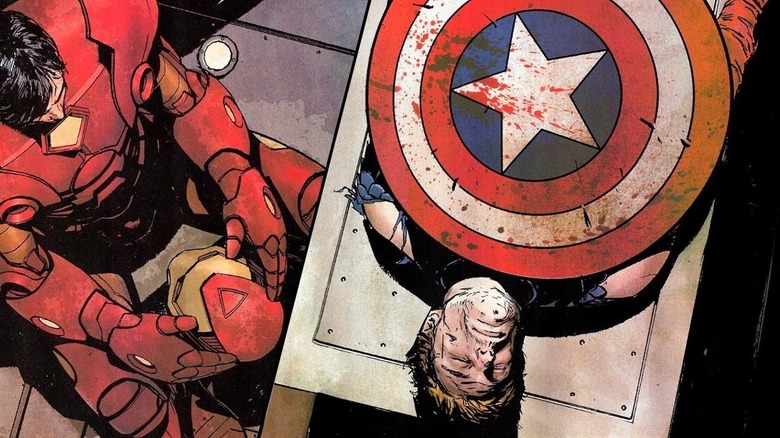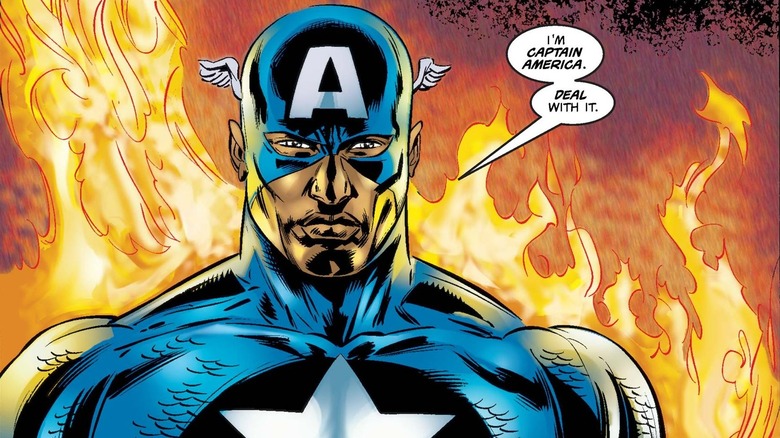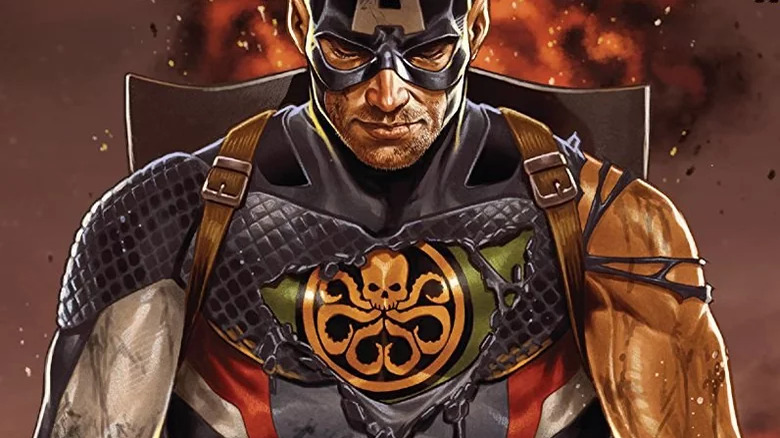Ways Marvel Lied To You About Captain America
Chris Evans and Anthony Mackie's time as Captain America have given the character a level of stardom, staying power, and importance that many of his fans never could have dreamed of twenty years ago. With three blockbuster films and a live-action television series now under his belt, Captain America has never been a more prominent symbol of the United States, its ideals, and its struggles to actually achieve them.
Unfortunately, with 80 years of storytelling under his belt, Cap's many creators haven't always been truthful. Marvel has built a decent collection of mis-truths it has told over the years while aiming to surprise, distract, and mislead its many readers while telling new stories and changing old ones. These kinds of "lies" are far from devious and are pretty standard fair for long-lived comic book characters like Iron Man and the other Avengers, but they aren't exactly truthful either.
The curious case of punching Hitler in the jaw
When Joe Simon and Jack Kirby were creating Captain America, they decided that Cap needed a realistic and believable villain on the cover to catch readers' attention, and they decided that the best choice for this position could only be the most despicable man on the planet. Thus, the cover of "Captain America Comics" #1, the character's very first appearance, prominently featured Steve Rogers punching Adolf Hitler a full year before the United States would enter World War II against Nazi Germany.
The two Jewish creators were, quite understandably, already deeply opposed to Hitler and his Nazi Party, and chose to make that perfectly clear despite the death threats that would quickly follow. Humorously enough, however, the cover in question is actually a bit of a fib and has maintained a curious place in Marvel Comics continuity to this day because the scene on the cover never actually happens in the comic, or in any of the issues that followed.
Like many, many comic book covers, the image promises a moment that never appears in the comic book, but sucks in any potential reader flipping past it on the spinner rack. Ask any kid who has ever bought a comic, and they'll probably call it a lie; ask any adult, and it's simply clever marketing.
Because of all this, whether or not Cap actually socked Hitler in the jaw is up for debate in the terms of Marvel Comics canon. Decades later, tales like "Captain America" #255 and "War of the Realms Strikeforce: The Land of Giants" #1, however, finally did confirm that the event happened in one form or another. It also made for a great, tongue-in-cheek element of the hero's promotion by the military in the first Chris Evans-starring "Captain America" flick, where he tells someone: "I've knocked out Adolf Hitler over 200 times."
The super soldier serum made him superhuman
When Stan Lee first brought Captain America back into the fold in "Avengers" #4, there were a number of now-classic aspects of the character that still hadn't been ironed out, and one of the most surprising is how the iconic Super-Soldier Serum affected Steve Rogers. In the modern day, the Serum transforms the frail Steve Rogers into the vaguely superhuman Captain America. He's infinitely less superhuman than characters like Thor or Hulk, but he can perform physical feats that normal humans couldn't dream of.
When Steve Rogers was first reintroduced, however, this was far from the case. Though many people know how the Serum once made people "peak-human," not superhuman, many don't realize that, originally, the Serum neither stayed in the subjects' system nor kept them at the physical peak it transformed them into.
Many mentions are made in Captain America's early stories in "Tales of Suspense" that he has to train constantly to keep up his incredible conditioning. When the Super Soldier Serum was removed from Steve Rogers in 2014's "Captain America" #22 comic, he reverted back to his scrawny, pre-Serum self. But if this very thing had happened in the '60s, Steve Rogers wouldn't have changed at all, because it was just a way to get there, not stay there.
Bucky wasn't just Camp Lehigh's "Camp Mascot"
When Bucky Barnes was introduced in 1941's "Captain America Comics" #1, he was just Cap's plucky teenage sidekick, an orphan who, because of his dad's great military career, was essentially adopted by Camp Lehigh. He only became Cap's sidekick because he knew Steve's secret identity after accidentally walking in on him changing into his Captain America uniform. He received military training after this, but was never much more than Steve's assistant.
This all changed in 2005 during Ed Brubaker's legendary run on "Captain America." In issue #12, Brubaker showed readers a series of flashbacks that retold and reframed Bucky's backstory. No longer was he just some kid who stumbled into heroism. He was "the best natural fighter" that the camp's general had ever seen, and had already trained with the SAS, British special forces, and the same people that trained Steve.
Additionally, his role in the war was a lot more brutal than it had been before. Though officially Bucky was meant to be a symbolic counter to the Hitler Youth, "Captain America" #5 established that his real purpose was to do all of the gruesome, dirty work of war that Captain America couldn't be seen doing. He was the advance scout that would sneak behind enemy lines and assassinate commanders, taking out perimeter guards to clear the way for more open assaults. "Dark Reign: The List – Avengers" #1 even claims that Bucky killed Adolf Hitler.
Steve Rogers and Bucky Barnes were active during the 1950s
When Stan Lee reintroduced Captain America, he explained Steve's absence by saying he had been frozen in ice in 1945, but was thawed out when the Avengers finally found him decades later. Unfortunately, this retcon created a new problem: since both Steve Rogers and Bucky Barnes continued to appear in comic book stories well into the 1950s, these stories were suddenly rendered outside the official canon. The problem was ignored by Marvel until Steve Englehart's Captain America #153 resolved the issue in 1972 in a particularly convoluted way.
Obsessed with Captain America, 1950s historian William Burnside accidentally discovered a copy of the Super Soldier Serum formula. Filled with dreams of becoming the new Captain America, he gave it to the US government in exchange for becoming the new Captain America and serving in the Korean War, but when the fighting ended before the project was finished, the government shut the program down.
Burnside would have none of it. The man had already recruited a boy named Jack Monroe to be his "Bucky," and the pair had changed their names, faces, and voices to exactly match Steve Rogers and Bucky Barnes. They took the unfinished Serum and, for a time, became the new Captain America and Bucky. Unfortunately, the flawed formula eventually caused the pair to go insane, and they were restrained in suspended animation.
Thus, the 1950s Captain America stories did happen, and they did feature two men named Steve Rogers and Bucky Barnes — but for very convoluted reasons, they were actually deranged imposters.
Steve Rogers was the only Captain America
Though both Bucky Barnes and Sam Wilson have famously served as Captain America when Steve Rogers could not, Marvel eventually revealed that there had, in fact, been many Captain Americas before them. In addition to William Burnside, several other men served as Captain America while Steve was frozen.
The first of these was Isaiah Bradley. Introduced in "Captain America: Patriot and Truth: Red, White & Black" and recently played by Carl Lumbly in "The Falcon and the Winter Soldier," Bradley was one of 300 African-American soldiers who were experimented on unwillingly by the US government in their efforts to recreate the Super Soldier Serum after Dr. Erskine's death. He was one of the only survivors, but when he stole a Captain America uniform and shield meant for Steve Rogers in order to destroy a Nazi super soldier program, he was arrested upon his return and experimented on further into his old age.
There were also two "official" replacements: William Nasland and Jeffrey Mace. Both were costumed superhero allies of Captain America during World War II, and when Steve went missing, the president asked Nasland to become the new Cap in order to keep up morale. When Nasland died, Mace was asked to do the same, and he managed to survive through the end of the war. Though neither had the Super Soldier Serum or Cap's famous shield, both men served with bravery and distinction and their stories were told in the 2011 graphic novel "Captain America: Patriot."
Captain America is an official position
"Captain America" is often presented as an official position granted by the US government, but as Contessa Valentina Allegra de la Fontaine pointed out in the MCU's "The Falcon and the Winter Soldier," the shield doesn't really belong to them, and though the government often "officially" ordains new Captain Americas in the comics, the mantle and legacy doesn't really belong to them either.
The "owner" of the title and shield is, for all intents and purposes, Steve Rogers. At the end of the day, he is Captain America, and the two most successful people to have replaced him were both chosen by Steve. When others like William Burnside and John Walker took on the mantle apart from Steve, their journeys ended horribly.
Marvel's "The United States of Captain America" is challenging that idea, however. A celebration of his 80th anniversary, the comic book miniseries introduced fans to five "local" Captain Americas who each work to protect different types of communities in the US.
Aaron Fischer is the "Captain America of the Railways" who fights to protect runaways and homeless youths. Nichelle Wright, on the other hand, is the "vanguard of a brighter future" while the Kickapoo Tribe's Joe Gomez is the "champion of the overlooked," Ari Agbayani takes down abusers on her college campus, and US Air Force Captain Jeremy Merrick fights for veteran's rights. Like America's democracy, the idea of Captain America belongs to the people, not the political elite.
Captain America returned a year early to fight the Human Torch
If one was to look up when Captain America returned in the comics, they might be surprised to discover he was reintroduced in 1964's "Avengers" #4. Because although this is correct, they could also see him on the cover of 1963's "Strange Tales" #114, which proudly announced the grand return of the Golden Age icon to challenge the Fantastic Four's Human Torch.
After witnessing a robbery at an antique auto show, the Human Torch is surprised to see his super-heroics upstaged by none other than Captain America. Though the figure is wearing red shorts as opposed to the classic blue, he seems to be the genuine article and is readily accepted by the public after foiling the heist. Everything seems on the up-and-up until readers see "Captain America" break the robbers out of jail to serve as a distraction while he robs a bank.
After Human Torch stops the robbers and gets them to confess, he confronts "Cap" and, after a lengthy battle, takes off his mask and discovers that the imposter is really Carl Zante, also known as "The Acrobat" — a thief with incredible gymnastics skills which allowed him to impersonate the patriotic hero of days gone by.
Bucky Barnes was dead
One of the most important parts of Steve Rogers' reintroduction to comics was the conceit that he had been frozen in suspended animation after being launched from a plane by an explosion that killed his partner, Bucky Barnes. For decades, Steve Rogers was constantly plagued by his ever-present, overwhelming sense of guilt due to his inability to save Bucky's life.
Then, in 2005, Ed Brubaker rocked Captain America to his core when he revealed that the Soviet super-assassin The Winter Soldier was none other than Bucky Barnes. Marvel had told fans for decades he was dead, but he had been alive the entire time.
The Russians had recovered Bucky's body after the explosion and managed to revive him, brainwash him, and give him a new robotic arm to finish his transformation into their personal tool of destruction. Keeping him in suspended animation until he was needed for a mission or to help train the initiates of the Red Room, Bucky had served as a killing machine for decades, and Steve was none the wiser.
His shield was always indestructible
Captain America's iconic shield is famous for its invulnerability, its ability to absorb extreme impacts, and for the way it ricochets every time it is thrown, finding its way back to Captain America's hands. Though this is accepted as fact in the Marvel Comics canon now, it wasn't for the first several decades of the patriotic hero's existence.
When he was first introduced, the nature of his shield wasn't really explored, and after he returned in 1964 to join the Avengers, his shield was shown to be made of normal metal on several occasions and was even destroyed by the Living Laser in 1966's "Avengers" #35 and replaced without comment in subsequent issues. The shield, at the time at least, was far less important than the man who carried it.
Though it's unclear exactly when the shield's indestructibility was first introduced, 1980's "Captain America" #255 finally established that his round, invulnerable shield was given to him by President Franklin Roosevelt himself to replace the original "heater shield" Steve used in "Captain America Comics" #1. Thus, with this story in place, the quality of Steve's shield was retconned, and it really shouldn't have vaporized way back in 1966.
John Walker killed his best friends after becoming Captain America
Made famous by Wyatt Russell's performance in "The Falcon and the Winter Soldier," John Walker was originally introduced as "Super-Patriot" in "Captain America" #323. He was essentially a more extreme version of Captain America who had received super-strength from the Power Broker alongside three of his friends, Lemar Hoskins, Hector Lennox, and Jerome Johnson.
When John Walker replaced Steve Rogers as the "official" Captain America in "Captain America" #333, he asked all of them to be his new partners, but after running background checks on the three men, the US government would only allow Lemar Hoskins to become John's new partner "Battlestar." Enraged, Hector Lennox and Jerome Johnson took on the ill-conceived names of "Left-Winger" and "Right-Winger" and became some of John's first supervillains.
The two men eventually revealed Walker's secret identity on national television and thus indirectly caused the deaths of his parents. This loss proved the beginning of a mental breakdown that led Walker to threaten Lennox and Johnson's parents in revenge unless they fought him at an oil refinery. After he beat them, Walker tied them up near a massive oil drum, lit a torch, and walked away as it exploded, murdering them ... until "Avengers West Coast" #61 established that they weren't dead and "Captain America" #383 made clear that Walker had gone back and managed to save them, though they were scarred horribly and later died anyway, so it wasn't exactly better.
Steve Rogers was dead
In 2007, Marvel Comics' "Civil War" event miniseries ended with Captain America surrendering to Tony Stark and his Pro-Registration Act forces. Though Steve was still vehemently opposed to forcing heroes to publicly register with the government, he realized that physically fighting against Iron Man's team had escalated too far. Prepared to face his day in court and present his argument there, Steve was instead gunned down on the steps of the Supreme Court building by his long-time villain Crossbones in "Captain America" #25.
Captain America was dead, except for the fact that he wasn't. It turns out that Sharon Carter was actually the one who had shot Steve, and when she finally tracked down the gun she shot him with in "Captain America" #600, she discovered that she hadn't killed Steve at all. Instead, the weapon was created by super-villains to cast Steve's consciousness into the time stream so that the Red Skull could take over Steve's body for himself.
During the events of "Captain America: Reborn," Steve's friends and allies manage to restore Steve to his body and defeat the Red Skull once and for all. Despite all of the memorial services and news reports to the contrary, Steve had never actually been dead.
Sam Wilson first became Captain America in 2014
In 2014, Sam Wilson made history when he became Captain America for the first time in "Captain America" #25 — or at least, he would have if he hadn't already done so over a decade earlier. Though his page on Marvel Comics official website still "lies" by incorrectly listing the 2014 issue as the first time he became Captain America, Sam Wilson actually wore the stars and stripes and carried the iconic shield in to battle in 1999 for "Captain America: Sentinel of Liberty" #9.
When the white-supremacist terrorist group Sons of the Serpent rebranded themselves as the "Sons of the Shield" and falsely claimed that Captain America was their leader, they staged an elaborate riot in Harlem to kidnap Steve Rogers and try to mind-control him. Believing Steve to be dead, Sam Wilson took on the Captain America title as he attempted to end the violence in Harlem while terrorists openly attacked people on the street.
Eventually, Sam tracked the Sons of the Serpent to their new headquarters and discovered what they had done to Steve. After a pitched battle, Sam managed to break the technology that was controlling Steve's mind, freeing him before stopping the Sons' plans to release a deadly virus into New York City. When the two men had both recovered, Steve thanked Sam for freeing him and for taking over while he was gone.
Steve Rogers was a Hydra sleeper agent all along
When Steve Rogers was reduced to the body of an old man after having the Super Soldier Serum removed from his system in 2014's "Captain America" #21, he asked Sam Wilson to become the new Captain America, and when he was restored to full health, the two men decided to share the mantle and both operate as the famous patriotic hero at the same time. Then "Steve Rogers: Captain America" #1 hit store shelves in 2016 and seemingly changed history forever: Steve Rogers was a secret Hydra sleeper agent. He had been a Nazi the whole time.
Fans were understandably outraged at a retcon that completely and utterly betrayed everything Steve Rogers had stood for and symbolized for over 75 years. Steve supposedly schemed his whole life against every person he had ever considered q friend, manipulating Sam Wilson until he became so disillusioned with life that he gave up being a superhero for good. Fans were outraged, and that feeling didn't lessen when Marvel revealed it had all been a cheap trick, a gimmick. They had lied.
The events of "Secret Empire" revealed that this "Steve Rogers" was actually the Captain America of a different universe entirely, one Hydra had brought to the Prime Marvel Universe using a "living cosmic cube" named Kobik. Armed with this knowledge, Sam Wilson became Captain America once again and led Earth's Mightiest Heroes to victory over Hydra after restoring the real Steve Rogers to the correct universe.
